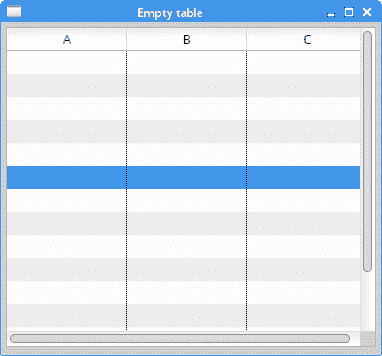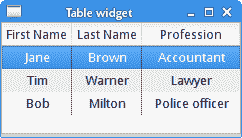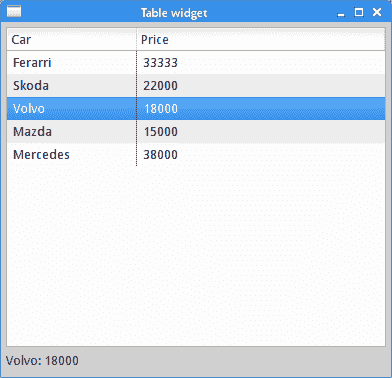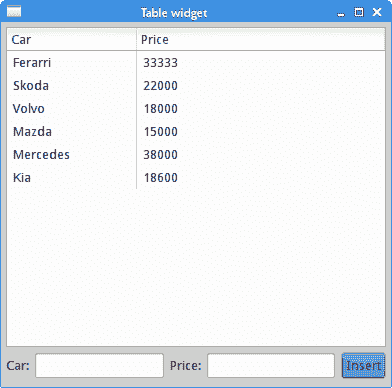Table小部件
在 Java SWT 教程的这一部分中,我们介绍Table小部件。 Table是细胞的二维网格。 可以将数据写入这些单元中的每一个中。 该小部件由电子表格应用引入。
Table可以显示列标题,并且当单元格很多时,Table可以显示滚动条。
空表
第一个示例创建一个简单的空表。
TableEx.java
package com.zetcode;
import org.eclipse.swt.SWT;
import org.eclipse.swt.layout.GridData;
import org.eclipse.swt.layout.GridLayout;
import org.eclipse.swt.widgets.Display;
import org.eclipse.swt.widgets.Shell;
import org.eclipse.swt.widgets.Table;
import org.eclipse.swt.widgets.TableColumn;
import org.eclipse.swt.widgets.TableItem;
/**
* ZetCode Java SWT tutorial
*
* In this program, we create a simple, empty
* table widget.
*
* Author: Jan Bodnar
* Website: zetcode.com
* Last modified: June 2015
*/
public class TableEx {
public TableEx(Display display) {
initUI(display);
}
@SuppressWarnings("unused")
private void initUI(Display display) {
Shell shell = new Shell(display);
shell.setLayout(new GridLayout());
Table table = new Table(shell, SWT.BORDER);
table.setHeaderVisible(true);
table.setLinesVisible(true);
GridData data = new GridData(SWT.FILL, SWT.FILL, true, true);
data.heightHint = 300;
data.widthHint = 350;
table.setLayoutData(data);
String[] titles = { "A", "B", "C" };
for (int i = 0; i < titles.length; i++) {
TableColumn column = new TableColumn(table, SWT.CENTER);
column.setWidth(120);
column.setText(titles[i]);
}
for (int i = 0; i < 15; i++) {
TableItem item = new TableItem(table, SWT.NONE);
}
shell.setText("Empty table");
shell.pack();
shell.open();
while (!shell.isDisposed()) {
if (!display.readAndDispatch())
display.sleep();
}
}
@SuppressWarnings("unused")
public static void main(String[] args) {
Display display = new Display();
TableEx ex = new TableEx(display);
display.dispose();
}
}
该代码示例创建一个具有三列和十五行的表小部件。 表单元为空。
Table table = new Table(shell, SWT.BORDER);
创建Table小部件的实例。
table.setHeaderVisible(true);
setHeaderVisible()使表格标题可见。 标题由表列名称组成。
table.setLinesVisible(true);
setLinesVisible()显示表格单元格的边框。 默认情况下,单元格不可见。
String[] titles = { "A", "B", "C" };
这些是列标题。
for (int i = 0; i < titles.length; i++) {
TableColumn column = new TableColumn(table, SWT.CENTER);
column.setWidth(120);
column.setText(titles[i]);
}
在此for循环中,我们创建表列。 TableColumn的实例表示表窗口小部件中的一列。 setWidth()设置列的宽度,setText()方法设置列的名称。
for (int i = 0; i < 15; i++) {
TableItem item = new TableItem(table, SWT.NONE);
}
TableItem代表表中的一行。 这段代码创建了十五个空单元格。

图:空表
用数据填充单元格
在第二个示例中,表格单元格显示一些数据。
TableEx2.java
package com.zetcode;
import org.eclipse.swt.SWT;
import org.eclipse.swt.layout.FillLayout;
import org.eclipse.swt.widgets.Display;
import org.eclipse.swt.widgets.Shell;
import org.eclipse.swt.widgets.Table;
import org.eclipse.swt.widgets.TableColumn;
import org.eclipse.swt.widgets.TableItem;
/**
* ZetCode Java SWT tutorial
*
* In this program, we fill table cells
* with data.
*
* Author: Jan Bodnar
* Website: zetcode.com
* Last modified: June 2015
*/
public class TableEx2 {
public TableEx2(Display display) {
initUI(display);
}
private void initUI(Display display) {
Shell shell = new Shell(display, SWT.SHELL_TRIM | SWT.CENTER);
shell.setLayout(new FillLayout());
Table table = new Table(shell, SWT.BORDER);
table.setHeaderVisible(true);
table.setLinesVisible(true);
TableColumn tc1 = new TableColumn(table, SWT.CENTER);
TableColumn tc2 = new TableColumn(table, SWT.CENTER);
TableColumn tc3 = new TableColumn(table, SWT.CENTER);
tc1.setText("First Name");
tc2.setText("Last Name");
tc3.setText("Profession");
tc1.setWidth(70);
tc2.setWidth(70);
tc3.setWidth(80);
TableItem item1 = new TableItem(table, SWT.NONE);
item1.setText(new String[] { "Jane", "Brown", "Accountant" });
TableItem item2 = new TableItem(table, SWT.NONE);
item2.setText(new String[] { "Tim", "Warner", "Lawyer" });
TableItem item3 = new TableItem(table, SWT.NONE);
item3.setText(new String[] { "Bob", "Milton", "Police officer" });
shell.setText("Table widget");
shell.pack();
shell.open();
while (!shell.isDisposed()) {
if (!display.readAndDispatch())
display.sleep();
}
}
@SuppressWarnings("unused")
public static void main(String[] args) {
Display display = new Display();
TableEx2 ex = new TableEx2(display);
display.dispose();
}
}
该示例显示了具有三列三行的表格小部件。 单元格充满数据。
TableItem item1 = new TableItem(table, SWT.NONE);
item1.setText(new String[] { "Jane", "Brown", "Accountant" });
setText()方法用数据填充一行的所有三个单元格。

图:带有数据的表格单元
选择表格行
以下示例介绍了表格项目的选择。
TableEx3.java
package com.zetcode;
import org.eclipse.swt.SWT;
import org.eclipse.swt.layout.GridData;
import org.eclipse.swt.layout.GridLayout;
import org.eclipse.swt.widgets.Display;
import org.eclipse.swt.widgets.Label;
import org.eclipse.swt.widgets.Shell;
import org.eclipse.swt.widgets.Table;
import org.eclipse.swt.widgets.TableColumn;
import org.eclipse.swt.widgets.TableItem;
/**
* ZetCode Java SWT tutorial
*
* In this program, we show the data from
* the selected row in the statusbar.
*
* Author: Jan Bodnar
* Website: zetcode.com
* Last modified: June 2015
*/
public class TableEx3 {
private Label label;
private final String data[][] = { { "Ferarri", "33333" },
{ "Skoda", "22000" }, { "Volvo", "18000" }, { "Mazda", "15000" },
{ "Mercedes", "38000" } };
public TableEx3(Display display) {
initUI(display);
}
private void initUI(Display display) {
Shell shell = new Shell(display, SWT.SHELL_TRIM | SWT.CENTER);
shell.setLayout(new GridLayout(1, true));
Table table = new Table(shell, SWT.BORDER);
table.setHeaderVisible(true);
table.setLinesVisible(true);
String[] titles = { "Car", "Price" };
for (int i = 0; i & titles.length; i++) {
TableColumn column = new TableColumn(table, SWT.NULL);
column.setText(titles[i]);
column.setWidth(130);
}
for (int i = 0; i & data.length; i++) {
TableItem item = new TableItem(table, SWT.NULL);
item.setText(0, data[i][0]);
item.setText(1, data[i][1]);
}
label = new Label(shell, SWT.NONE);
table.addListener(SWT.Selection, event -> onTableItemSelected(table));
GridData gd = new GridData(SWT.FILL, SWT.FILL, true, true);
gd.widthHint = 360;
gd.heightHint = 300;
table.setLayoutData(gd);
label.setLayoutData(new GridData(SWT.FILL, SWT.CENTER, true, false));
shell.setText("Table widget");
shell.pack();
shell.open();
while (!shell.isDisposed()) {
if (!display.readAndDispatch())
display.sleep();
}
}
private void onTableItemSelected(Table table) {
TableItem[] sel = table.getSelection();
String msg = String.format("%s: %s", sel[0].getText(0),
sel[0].getText(1));
label.setText(msg);
}
@SuppressWarnings("unused")
public static void main(String[] args) {
Display display = new Display();
TableEx3 ex = new TableEx3(display);
display.dispose();
}
}
在示例中,所选行中的数据显示在状态栏中。
table.addListener(SWT.Selection, event -> onTableItemSelected(table));
选择监听器将添加到表中。 每当选择表格项目时,都会调用onTableItemSelected()。
private void onTableItemSelected(Table table) {
TableItem[] sel = table.getSelection();
String msg = String.format("%s: %s", sel[0].getText(0),
sel[0].getText(1));
label.setText(msg);
}
getSelection()方法返回一个选定表项的数组。 (由于我们使用默认选择模式(即单选模式),因此仅返回一个表项。)我们使用getText()方法从该行的单元格中检索数据。 我们构建消息并使用其setText()方法将其显示在标签中。

图:选择表项
添加新表项
在以下示例中,新表项被动态添加到表中。
TableEx4.java
package com.zetcode;
import org.eclipse.swt.SWT;
import org.eclipse.swt.layout.GridData;
import org.eclipse.swt.layout.GridLayout;
import org.eclipse.swt.widgets.Button;
import org.eclipse.swt.widgets.Display;
import org.eclipse.swt.widgets.Event;
import org.eclipse.swt.widgets.Label;
import org.eclipse.swt.widgets.Shell;
import org.eclipse.swt.widgets.Table;
import org.eclipse.swt.widgets.TableColumn;
import org.eclipse.swt.widgets.TableItem;
import org.eclipse.swt.widgets.Text;
/**
* ZetCode Java SWT tutorial
*
* In this program, we add new table items
* to the table.
*
* Author: Jan Bodnar
* Website: zetcode.com
* Last modified: June 2015
*/
public class TableEx4 {
private Text text1;
private Text text2;
private Table table;
private final String data[][] = { { "Ferarri", "33333" },
{ "Skoda", "22000" }, { "Volvo", "18000" }, { "Mazda", "15000" },
{ "Mercedes", "38000" } };
public TableEx4(Display display) {
initUI(display);
}
private void initUI(Display display) {
Shell shell = new Shell(display, SWT.SHELL_TRIM | SWT.CENTER);
shell.setLayout(new GridLayout(5, false));
table = new Table(shell, SWT.BORDER | SWT.MULTI);
table.setHeaderVisible(true);
// table.setLinesVisible(true);
String[] titles = { "Car", "Price" };
for (int i = 0; i < titles.length; i++) {
TableColumn column = new TableColumn(table, SWT.NULL);
column.setText(titles[i]);
column.setWidth(130);
}
for (int i = 0; i < data.length; i++) {
TableItem item = new TableItem(table, SWT.NULL);
item.setText(0, data[i][0]);
item.setText(1, data[i][1]);
}
GridData gd = new GridData(SWT.FILL, SWT.FILL, true, true);
gd.horizontalSpan = 5;
gd.widthHint = 360;
gd.heightHint = 300;
table.setLayoutData(gd);
Label carName = new Label(shell, SWT.NONE);
carName.setText("Car:");
text1 = new Text(shell, SWT.BORDER);
Label priceOfCar = new Label(shell, SWT.NONE);
priceOfCar.setText("Price:");
text2 = new Text(shell, SWT.BORDER);
text1.setLayoutData(new GridData(SWT.FILL, SWT.CENTER, true, false));
text2.setLayoutData(new GridData(SWT.FILL, SWT.CENTER, true, false));
Button addBtn = new Button(shell, SWT.PUSH);
addBtn.setText("Insert");
addBtn.addListener(SWT.Selection, event -> onInsertButtonSelected(event));
shell.setText("Table widget");
shell.pack();
shell.open();
while (!shell.isDisposed()) {
if (!display.readAndDispatch())
display.sleep();
}
}
private void onInsertButtonSelected(Event event) {
String val1 = text1.getText();
String val2 = text2.getText();
if (val1.isEmpty() || val2.isEmpty()) {
return;
}
TableItem item = new TableItem(table, SWT.NULL);
item.setText(0, val1);
item.setText(1, val2);
text1.setText("");
text2.setText("");
}
@SuppressWarnings("unused")
public static void main(String[] args) {
Display display = new Display();
TableEx4 ex = new TableEx4(display);
display.dispose();
}
}
在底部,有两个文本小部件和一个按钮。 插入到文本小部件中的数据将插入到新表项的单元格中。
private void onInsertButtonSelected(Event event) {
String val1 = text1.getText();
String val2 = text2.getText();
...
}
在onInsertButtonSelected()方法中,我们从文本小部件中获取插入的文本。
if (val1.isEmpty() || val2.isEmpty()) {
return;
}
我们确保文本小部件不为空。
TableItem item = new TableItem(table, SWT.NULL);
item.setText(0, val1);
item.setText(1, val2);
构造新表项,并获取插入的数据。
text1.setText("");
text2.setText("");
最后,将清除文本小部件。

图:添加新表项
在 Java SWT 教程的这一部分中,我们介绍了Table小部件。

